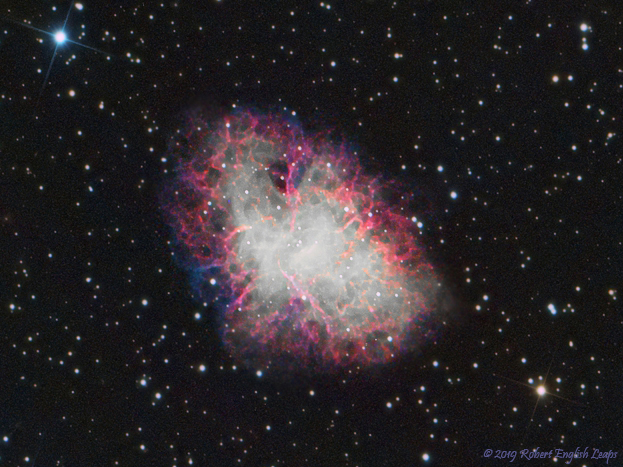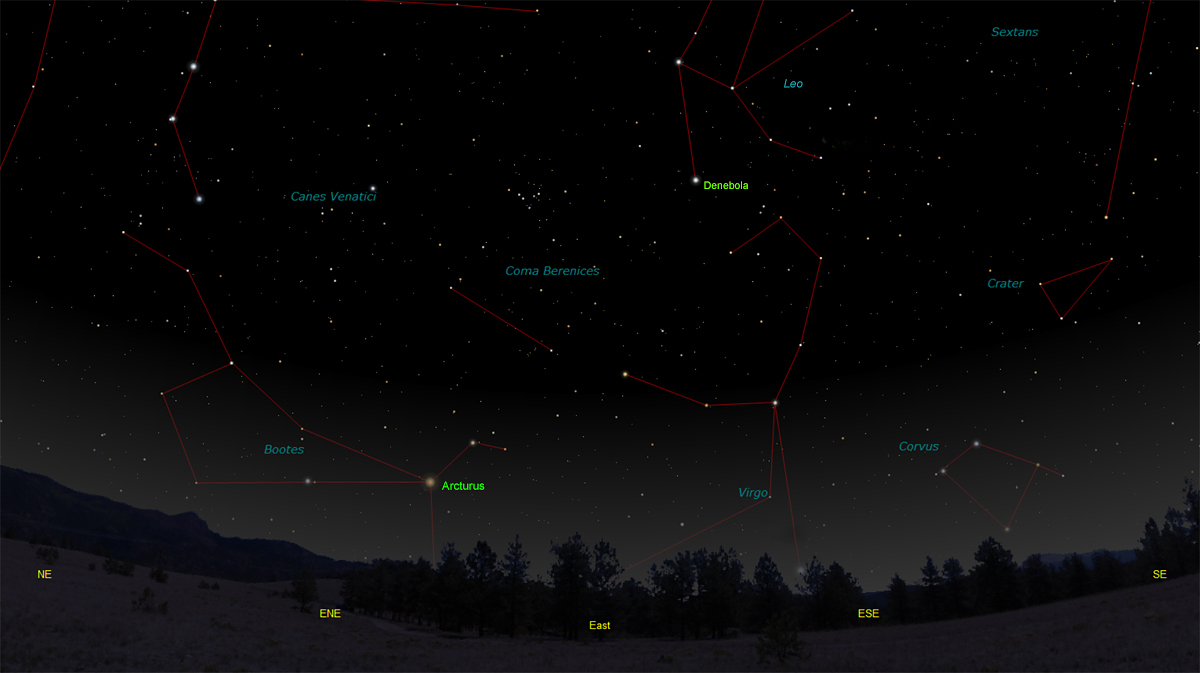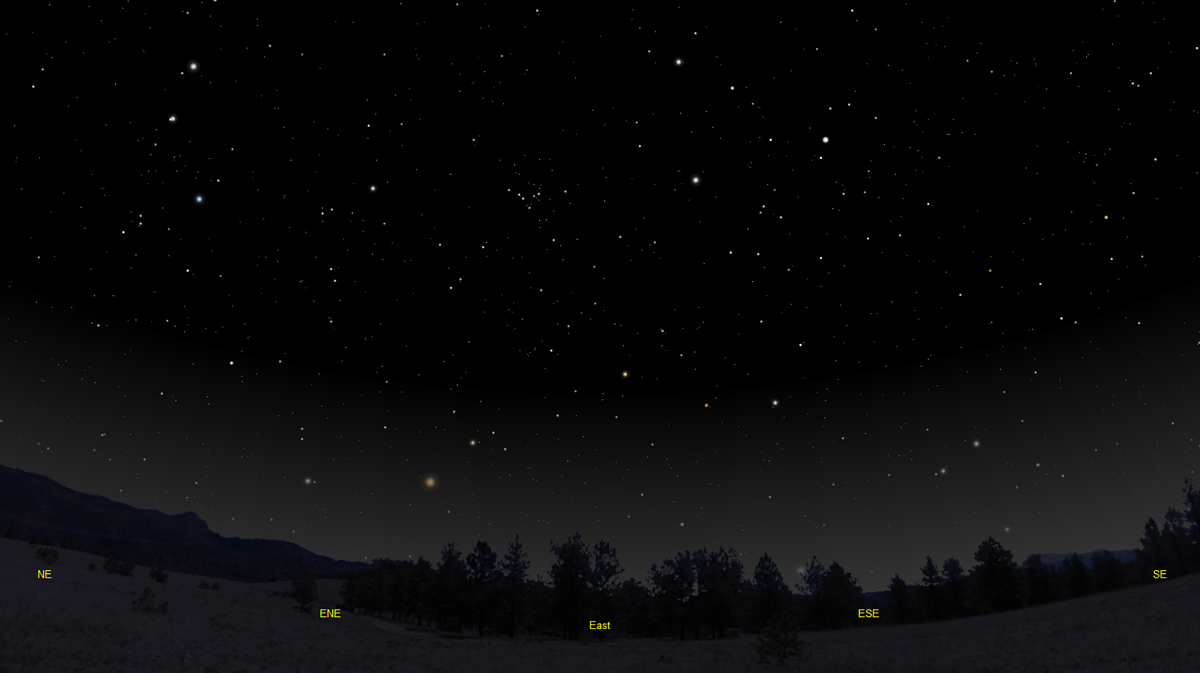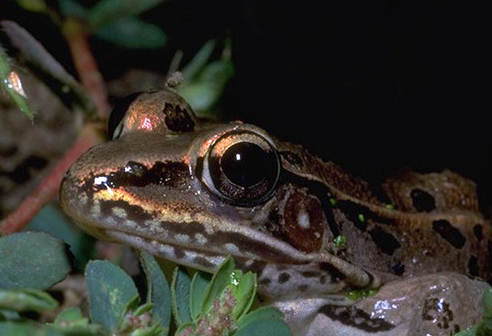The purpose of this feature is to give scout leaders, educators and naturalists an idea of some of the natural events coming up each month. We will try to cover a variety of natural events ranging from sky events to calling periods of amphibians, bird and mammal watching tips, prominent wildflowers and anything else that comes to mind. We will also note prominent constellations appearing over the eastern horizon at mid-evening each month for our area for those who would like to learn the constellations. If you have suggestions for other types of natural information you would like to see added to this calendar, let us know! Note: You can click on the hyperlinks to learn more about some of the featured items. To return to the Calendar, hit the "back" button on your browser, NOT the "back" button on the web page. All charts are available in a "printer friendly" mode, with black stars on a white background. Left clicking on each chart will take you to a printable black and white image. Please note that images on these pages are meant to be displayed at 100%. If your browser zooms into a higher magnification than that, the images may lose quality. Though we link book references to nationwide sources, we encourage you to support your local book store whenever possible.
Notes From February 2019
This month I've added a link to TAMP on the Leaps home page. So what is TAMP? The Tennessee Amphibian Monitoring Program (TAMP) is a joint venture between the Tennessee Wildlife Resources Agency and Middle Tennessee State University. I've been privileged to contribute data to TAMP for over 20 years. The database is kept by the Tennessee Wildlife Resources Agency. The TAMP website is still under construction, but I'm putting it up now to allow volunteers to access information about the program, and to access route information and forms.TAMP is a listening survey. A TAMP volunteer drives an assigned route, stopping at ten ordered stops along the way and recording each species he or she hears at each stop. Volunteers conduct their survey four times per year. With the data gathered from TAMP, we hope to better understand the distribution and relative abundance of each of the 22 species of frogs and toads that occur in Tennessee. These species face a variety of threats. With the progressive development of rural areas in Tennessee, the habitats of many of our frogs and toads are diminishing. The misuse of herbicides and pesticides adversely affects populations. Various pathogens are taking their toll. Changing climate may also threaten some species. Will rising winter temperatures negatively affect species that require cooler breeding temperatures? TAMP volunteers sometimes find species that have never been observed in a particular county. New county records are important because they help define the range of each species of frog and toad in Tennessee. New records are first submitted to Austin Peay State University. If they are approved by Austin Peay they can be published in periodicals like Herpetological Review. Range maps are then revised to reflect these new records. TAMP is not for everyone. Data forms must be filled out and an online quiz completed. Often there is considerable driving time involved in just getting to the start point of an official TAMP route. Driving a route requires navigating a rural road at night. Volunteers begin their routes after sunset, which may result in a return time close to midnight in the summer. But for those who want to make a lasting contribution to a body of knowledge about Tennessee frogs and toads, TAMP provides that opportunity. The data carefully gathered today will only become more valuable tomorrow. Biologists and land managers can use this data to determine where each species occurs and in what abundance. This knowledge is invaluable in making decisions about land use that benefit our amphibian populations, our environment and ourselves. Volunteers also gain by contributing to TAMP. They learn to identify Tennessee's frogs and toads by sight and sound, learn the habitats that each species prefers, and learn when each species is active. Volunteers often encounter night birds and nocturnal mammals. But perhaps the greatest benefits are those that don't show up on a data sheet. There are times when I'm standing by a wetland at twilight when I realize there's no other place I'd rather be. Whether I'm listening to a frog chorus, a distant owl or just enjoying the sound of the wind in the pines, just being out there is deeply satisfying. If you would like more information on the TAMP program, please email me at engc205@aol"dot"com or by phone at 615-210-8774.
Sky Events for March 2019: Spring begins in the Northern Hemisphere on March 20th at 5:58pm Eastern Daylight Time. Morning Sky:
Evening Sky: Mars moves from Aries into Taurus around the middle of the month. It's quite small in a telescope field of view, and by the end of the month is less than 5 seconds of an arc in apparent diameter. Its apparent motion this month brings it close to the Pleiades by the end of the month. Mercury will be visible low in the western sky after sunset for the first few days in March. It will quickly disappear in the twilight glow by the end of the first week of March. It always helps to pick a spot that has a flat horizon when trying to spot Mercury. It's fun though, because you can see it's change in position from day to day. The time changes from Eastern Standard Time to Eastern Daylight Time at 2:00am on March 10th.
The bright star Arcturus, in Bootes, the Herdsman, makes its appearance this month in the early evening sky, a sure sign that Spring is here. Virgo clears the horizon this month along with Corvus, the Crow. The area of sky encompassing Leo, Virgo and Como Berenices marks the heart of the great Virgo cluster of galaxies. In the early morning hours Virgo will have risen high enough in the sky to search for the many bright galaxies that are in this region. Messier 104, in southern Virgo just above Corvus, is one of the easier galaxies to spot in binoculars. Even so, you will need a dark and moonless night to be successful. Messier 1, The Crab Nebula, is high in the sky this month and can sometimes be spotted in binoculars in a location away from city lights. In larger telescopes you can visually make out the part of the nebula that appears whitish in the above image. To me it looks to me like a giant rabbit grazing in some cosmic field of grass. The faint red and blue tendrils are visible only large telescopes in very dark skies. The crab nebula is the remnant of a stellar explosion that was noted by Chinese astronomers in the year 1054. The star collapsed to a rapidly spinning neutron star, or pulsar. It spins at a rate of 30 revolutions per second. Distance to the nebula is 6,500 light-years from Earth. For more on the crab nebula, including finder charts and an interview with pulsar discoverer Jocelyn Bell Burnell, click here. The object is number one in 18th century French comet hunter Charles Messier's catalog of objects which might be confused with comets. In describing the appearance of the crab nebula, Messier said, "This nebula had such a resemblance to a comet, in its form and brightness, that I endeavored to find others, so that astronomers would not confuse these same nebulae with comets just beginning to shine." Messier ending up cataloging some of the most beautiful galaxies, nebulae and star clusters in the sky. On Learning the Constellations : We advise learning a few constellations each month, and then following them through the seasons. Once you associate a particular constellation coming over the eastern horizon at a certain time of year, you may start thinking about it like an old friend, looking forward to its arrival each season. The stars in the evening scene above, for instance, will always be in the same place relative to the horizon at the same time and date each March. Of course, the planets do move slowly through the constellations, but with practice you will learn to identify them from their appearance. In particular, learn the brightest stars (Like Arcturus and Denebola in the above scene looking east), for they will guide you to the fainter stars. Once you can locate the more prominent constellations, you can "branch out" to other constellations around them. It may take you a little while to get a sense of scale, to translate what you see on the computer screen or what you see on the page of a book to what you see in the sky. Look for patterns, like the stars of Corvus the Crow.The earth's rotation causes the constellations to appear to move across the sky just as the sun and the moon appear to do. If you go outside earlier than the time shown on the charts, the constellations will be lower to the eastern horizon. If you observe later, they will have climbed higher. As each season progresses, the earth's motion around the sun causes the constellations to appear a little farther towards the west each night for any given time of night. The westward motion of the constellations is equivalent to two hours per month. Recommended: Sky & Telescope's Pocket Star Atlas is beautiful, compact star atlas. A good book to learn the constellations is Patterns in the Sky, by Hewitt-White. You may also want to check out at H. A. Rey's classic, The Stars, A New Way to See Them. For sky watching tips, an inexpensive good guide is Secrets of Stargazing, by Becky Ramotowski.
A good general reference book on astronomy is the Peterson
Field Guide,
A Field Guide to the Stars and Planets, by Pasachoff. The book retails for around $14.00.
The Virtual Moon Atlas is a terrific way to learn the surface features of the Moon. And it's free software. You can download the Virtual Moon Atlas here. Apps: We really love the Sky Safari 6 Pro. It is available for both iOS and Android operating systems. There are three versions. The Pro is simply the best astronomy app we've ever seen. The description of the Pro version reads, "includes over 100 million stars, 3 million galaxies down to 18th magnitude, and 750,000 solar system objects; including every comet and asteroid ever discovered." A nother great app is the Photographer's Ephemeris. Great for finding sunrise, moonrise, sunset and moonset times and the precise place on the horizon that the event will occur. Invaluable not only for planning photographs, but also nice to plan an outing to watch the full moon rise. Available for both androids and iOS.
Amphibians:
Recommended: The Frogs and Toads of North America, Lang Elliott, Houghton Mifflin Co. Archives (Remember to use the back button on your browser, NOT the back button on the web page!) Natural Calendar February 2019 Natural Calendar December 2018 Natural Calendar November 2018 Natural Calendar February 2018 Natural Calendar December 2017 Natural Calendar November 2017 Natural Calendar October 2017Natural Calendar September 2017 Natural Calendar February 2017 Natural Calendar December 2016 Natural Calendar November 2016 Natural Calendar September 2016Natural Calendar February 2016 Natural Calendar December 2015 Natural Calendar November 2015 Natural Calendar September 2015 Natural Calendar November 2014 Natural Calendar September 2014 Natural Calendar September 2013 Natural Calendar December 2012 Natural Calendar November 2012 Natural Calendar September 2012 Natural Calendar February 2012 Natural Calendar December 2011 Natural Calendar November 2011 Natural Calendar September 2011 Natural Calendar December 2010 Natural Calendar November 2010 Natural Calendar September 2010 Natural Calendar February 2010 Natural Calendar December 2009 Natural Calendar November 2009 Natural Calendar September 2009 Natural Calendar February 2009 Natural Calendar December 2008 Natural Calendar November 2008 Natural Calendar September 2008 Natural Calendar February 2008 Natural Calendar December 2007 Natural Calendar November 2007 Natural Calendar September 2007 Natural Calendar February 2007 Natural Calendar December 2006 Natural Calendar November 2006 Natural Calendar September 2006 Natural Calendar February 2006
Natural Calendar December 2005
Natural Calendar November 2005
Natural Calendar September 2005
Natural Calendar February 2005
Natural Calendar December 2004
Natural Calendar November 2004
Natural Calendar September 2004
Natural Calendar February 2004
Natural Calendar December 2003
Natural Calendar November 2003 Natural Calendar February 2003 Natural Calendar December 2002 Natural Calendar November 2002 Nature Notes Archives: Nature Notes was a page we published in 2001 and 2002 containing our observations about everything from the northern lights display of November 2001 to frog and salamander egg masses. Night scenes prepared with The Sky Professional from Software Bisque All images and recordings © 2019 Leaps
|
|





